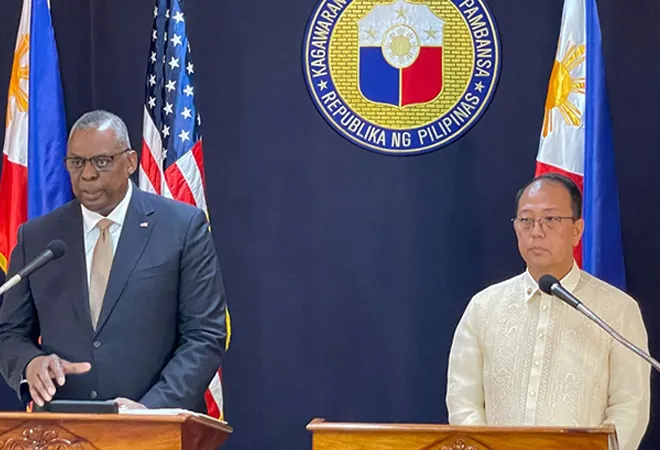
The Philippines and the United States (US) have
announced their plans “to accelerate the full implementation of the Enhanced Defense Cooperation Agreement (EDCA) by agreeing to designate four new ‘Agreed Locations’ in strategic areas of the country and the substantial completion of the projects in the existing five Agreed Locations”. The main
purpose of the EDCA is to support combined training, exercises, and interoperability between our forces. The EDCA also “grants the American military sweeping access to a wide range of vital military bases across the Philippines”. This took place during the
visit of US Defense Secretary Lloyd Austin to the Philippines on 2 February 2023, as part of a Western Pacific trip. During this visit, he held
meetings with Philippines’ President Ferdinand Marcos Jr., Defense Secretary Carlito Galvez Jr. and Foreign Affairs Secretary Enrique Manalo. The Philippines have been a long-time security ally of the United States and the EDCA forms the pillar of this relationship. According to a
statement released by the US, “Expansion of the EDCA will make our alliance stronger and more resilient and will accelerate the modernisation of our combined military capabilities. The addition of these new EDCA locations will allow more rapid support for humanitarian and climate-related disasters in the Philippines, and respond to other shared challenges.” Furthermore, the US has already
invested over US$82 million toward infrastructure investments at the existing five sites under the EDCA and ‘have committed to moving quickly in agreeing to the necessary plans and investments for the new and existing EDCA locations.’ The US
statement further read, “The Philippine-US Alliance has stood the test of time and remains ironclad. We look forward to the opportunities these new sites will create to expand our cooperation together.”
The EDCA also “grants the American military sweeping access to a wide range of vital military bases across the Philippines”.
In a press briefing held by Philippines’ Defense Secretary, Carlito Galvez Jr. and US Defence Secretary, Lloyd Austin, it was made
clear from the end of the US that “it was not seeking a permanent basing in the Philippines through the EDCA, instead, Washington was looking at access and the opportunity for the US to increase its training activities with the Philippines. It is about having the ability to respond in a more collective fashion… so this is an opportunity to increase our effectiveness, increase interoperability.” The four new locations have not been revealed by either of the countries yet. But there was news floating around a couple of months ago that the US has
identified and asked for five additional locations for the EDCA—one site each in Palawan, Zambales, and Isabela and two sites in Cagayan. The
five locations already allotted to the US under the EDCA are: the Antonio Bautista Air Base in Palawan, which is closest to the Kalayaan Island Group; Basa Air Base in Pampanga; Fort Magsaysay in Nueva Ecija, the country’s largest military camp; Benito Ebuen Air Base in Cebu in the Visayas and Lumbia Air Base in Cagayan de Oro City in Mindanao, which is located close to the disputed Scarborough Shoal and the Spratly islands in the Indo-Pacific. The EDCA was
signed between the US and the Philippines in 2014 to counter the growing Chinese assertiveness in the South China Sea and also to seek assistance from the US troops to respond to natural disasters. In January 2019,
the first major project of constructing a Humanitarian Assistance and Disaster Relief warehouse under the EDCA at Cesar Basa Air Base, Pampanga was completed. More projects and development work are
underway by the US in four other locations under the EDCA—Fort Magsaysay Military Reservation, Lumbia Air Base, Antonio Bautista Air Base, and Mactan Benito Ebuen Air Base.
This expanded access provided to the US to the Philippines’ military bases will give the US forces a
greater strategic footing on the southeastern edge of the South China Sea close to Taiwan. In a statement, US Defence Secretary Austin
said, “That’s just part of our efforts to modernise our alliance. And these efforts are especially important as the People’s Republic of China continues to advance its illegitimate claims in the West Philippine Sea”. The US has been stepping up its engagements with countries in the Indo-Pacific, and this can be seen not only from this stepped-up EDCA with the Philippines, but also the recently
launched US-India initiative on Critical and Emerging Technology (iCET), and also from the
plans to deploy new US Marine units to Japanese islands. The location of these four additional areas is also said to potentially place the US troops fewer than 200 miles south of Taiwan. The Biden administration has been upping its engagement with Taiwan and has also
reiterated that the US will stand by its commitments under the Taiwan Relations Act-“Washington agrees to provide the island with the means to defend itself without committing US troops.”
The first major project of constructing a Humanitarian Assistance and Disaster Relief warehouse under the EDCA at Cesar Basa Air Base, Pampanga was completed.
Given that the new Marcos administration’s policy approach marks a total shift from the previous Duterte administration, whereby the aim is to revamp ties with the US and to move away from a complete pro-China policy stand. The US is also gearing up to make the full use of this opportunity to re-ignite ties with its security ally in Southeast Asia given the rising tensions in the South China Sea and also Taiwan. The Philippines is the oldest treaty ally of the USand the foundation of this relationship rests on the 1951 Mutual Defence Treaty. With the coming of the new administration in the Philippines, some significant developments can be noticed in this bilateral relationship. In November 2022, US Vice President, Kamala Harris
visited the Philippines to discuss the scope of expanded base access by the US with President Ferdinand Marcos Jr. Furthermore, in October 2022, for the first time, the defence chiefs of the US and the Philippines met at the US Indo-Pacific Command in Honolulu, Hawaii to discuss initiatives which can further bolster the security alliance.
According to Richard Heydarian, Senior Lecturer at the University of Philippines, “Under EDCA, US troops will also be allowed to preposition weapons systems and basic military infrastructure, which will be crucial to America’s ability to project power in the Western Pacific.” He additionally
pointed out, “by building advanced military facilities in strategically-located Philippine bases, the US Pentagon will in future be in an optimal position to build both a forward deployment presence as well as jointly respond to nearby contingencies.”
The Marcos Jr. administration too have been making ample efforts to restore ties with theUS. President Ferdinand Marcos Jr. had his first personal meeting with US President Joe Biden on the sidelines of the United Nations General Assembly in New York. He also
praised the United States’ role “as an anchor of stability in the Indo-Pacific, which is something that is much appreciated by all the countries in the region, and the Philippines especially.” The Filipino Defence Chief during his visit to Hawaii had also
stated, “Our two countries are working together to reach a common understanding of the importance of our defence alliance…in advancing our respective country’s interests and promoting peace and prosperity in the region.”
The two countries are expected to increase joint military activities to as many as 500 next year, with the US expected to deploy 16,000 troops for the annual Balikatan exercises.
According to Filipino scholars, “the Philippines’ geography is increasingly seen as vital to the Pentagon’s operational priorities in the region. In particular, the Philippines’ northernmost and essentially uninhabited island of Mavulis, located in the Luzon Strait, is only 140 kilometres from Taiwan’s southernmost tip.” So many in the Philippines
believe in case conflict breaks out in Taiwan, it will have an impact on the Philippines and the island nation might also be involved or drawn into it in some capacity. A former Filipino military chief General Emmanuel Bautista had
stated, “The Philippines represents a “key terrain” for Sino-American competition, since it connects the South China Sea and the Pacific Ocean via the Sibutu Passage in the south and Bashi Channel and Luzon Strait in the north.”
The ramping of the US-Philippines defence ties and the decision to press hard for the full implementation of EDCA, will not only have an impact on the US-Philippines relations, but also on the Philippines-China and the US-China great power competition. This can further also have a counter effect on the overall South China Sea dispute and also the ongoing deliberations on the Code of Conduct (COC) for a peaceful settlement of the dispute. Though the new administration is aware, when it comes to security and defence of its sovereign territories, it does need the US, but for economic advancement and development, a healthy relationship with China is also needed. By taking such bold steps which directly sends out a strong message to China, how the Marcos Jr. administration will be able to balance and hedge between these two powers to draw benefits from both, which has been the mantra of most of his Southeast Asian neighbours remains to be seen.
The views expressed above belong to the author(s). ORF research and analyses now available on Telegram! Click here to access our curated content — blogs, longforms and interviews.



 The Philippines and the United States (US) have
The Philippines and the United States (US) have  PREV
PREV


